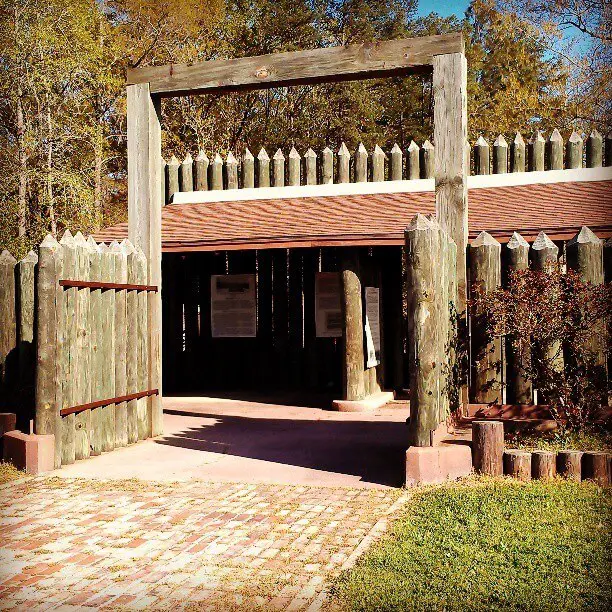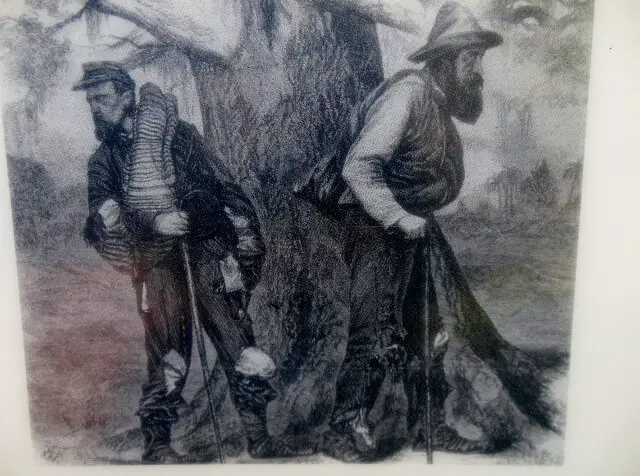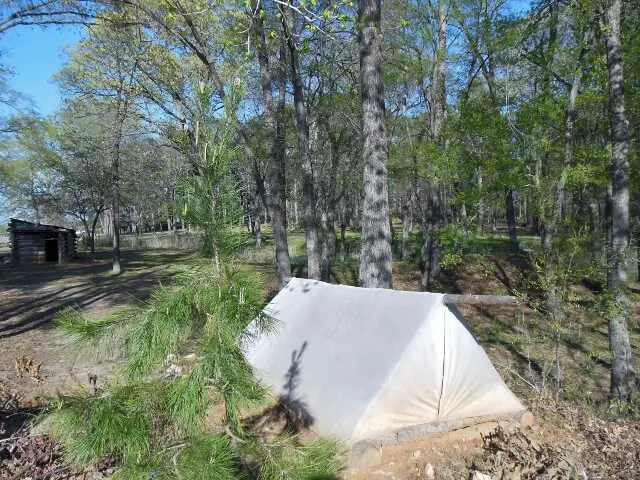Under the heading of “who knew?” Civil War history – the Confederacy’s largest POW (Prisoner of War) camp for captured Union soldiers west of the Mississippi River was Camp Ford, tucked deep into the woods of East Texas just outside of Tyler.
Today, Tyler is much better known as a center for rose horticulture – that’s why they call native son and football player Earl Campbell the “Tyler Rose” – so it’s a surprise to discover significant Civil War history this far west.
It’s also a good example of making something out of nothing, because nothing remains of the original camp except a few sections of foundation and some other telltale signs that it took an experienced team from Texas A&M’s Center for Ecological Archaeology to excavate, map out and interpret so that we could learn the Camp’s full story.

Reconstructed stockade entrance to Camp Ford Civil War historic site in Tyler, Texas (photo by Sheila Scarborough)
Somehow, the Smith County Historical Society has managed, through a combination of reconstruction, explanatory signage and an interpretive trail, to make the small site come alive for today’s visitors.
It is free to the public and open from dawn till dusk.
An example of a period tent and simple lean-to building demonstrate that the prisoners lived in whatever they could build themselves.
The path has a lot more signage on it than I expected, with detailed descriptions and drawings. The text does a good job of getting you to use your imagination as you turn and face in different directions, to see how things looked in that exact spot many years ago.

Union prisoners attempting escape from Confederate Camp Ford in Tyler, Texas (photo by Sheila Scarborough of a lithograph courtesy Texas State Archives)
Yes, the Union prisoners often tried to escape.
From the book Faded Glory: A Century of Forgotten Texas Military Sites by Alexander and Utley ….
“Rainy days in particular were considered ideal for planned escapes, since downpours erased footprints and foiled the hounds and trackers inevitably sent in pursuit. While many were successful in their endeavors, many also failed to make it far from the camp, sometimes inadvertently circling back to the area, confused by the thick woods.”
Official word about war’s end reached Camp Ford on May 13, 1865, and the remaining prisoners (about 1,200) were eventually taken by wagon to be released/exchanged in Shreveport, Louisiana, well to the east of Tyler.

Union soldiers 19th Iowa upon release from Camp Ford Tyler TX July 1864 (photo by Sheila Scarborough from Camp Ford display placard)
I spent a good hour at Camp Ford, reading the placards and walking the trail. It’s well worth a stop if you’re traveling through northeastern Texas.
If you like this post, please consider subscribing to the blog via RSS feed or by email – the email signup text link is at the top of the right sidebar above our Facebook Page link. Thanks!




Such an awesome post.. we for sure will add you and follow your adventures! You gotta come visit Alabama and write about it..
I’d love to come to Alabama; lots of history there!
Hi, I really enjoyed this article, I’ve always enjoyed reading about the events of the Civil War. Thanks for sharing this on the Byteful Travel Blog Carnival. I look forward to reading more of your posts.
Thanks,
Jim
The illustration of the two POWs escaping are Acting Volunteer Lieutenant Benjamin W. Loring, USA, the Captain of the USS Wave, Tinclad Number 45, and Lt. Col. Aaron M. Flory, 46th Indiana Volunteer Infantry, attempting to escape from Camp Groce, near Hempstead, Texas, and not Camp Ford. The illustration appeared on the cover of Leslie’s Weekly after they successfully escaped to Brasher City and boarded the USS Carondelet, Tinclad Number 49, and were transported to New Orleans, where they posed for photos that are the basis of the illustration in the article.
Follow Camp Groce CSA at: https://www.facebook.com/dlisarelli